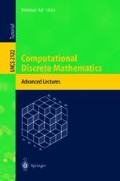Abstract
The most common algorithm for computing the determinant ofan n×n matrix A is Gaussian elimination and needs O(nsu3) additions, subtractions, multiplications, and divisions. On the other hand, the explicit definition of the determinant as the sum of n! products,
shows that the determinant can be computed without divisions. The summation is taken over the set of all permutations π of n elements. Avoiding divisions seems attractive when working over a commutative ring which is not a field, for example when the entries are integers, polynomials, or rational or even more complicated expressions. Such determinants arise in combinatorial problems, see [11].
Access this chapter
Tax calculation will be finalised at checkout
Purchases are for personal use only
Preview
Unable to display preview. Download preview PDF.
References
Martin Aigner, Lattice paths and determinants. In: Computational Discrete Mathematics, ed. Helmut Alt, (this volume), Lecture Notes Comput. Sci., Vol. 2122 2001, pp. 1–12.
Erwin H. Bareiss, Sylvester’s identity and multistep integer-preserving Gaussian elimination. Math. Comput. 22 (1968), 565–578.
Stuart J. Berkowitz, On computing the determinant in small parallel time using a small number of processors. Inf. Process. Lett. 18 (1984), 147–150.
Allan Borodin, Joachim von zur Gathen, John Hopcroft, Fast parallel matrix and GCD computations. Inf. Control 52 (1982), 241–256
E. Durant, Solution numérique des équations algébriques, tome II: systémes des plusieurs équations. Masson & Cie., Paris 1961.
Jack Edmonds, Systems of distinct representatives and linear algebra. J. Res. Nat. Bur. Standards, Sect. B 71 (1967), 241–245.
Jack Edmonds, J.-F. Maurras, Note sur les Q-matrices d’Edmonds. RAIRO, Rech. opér. 31 (1997), 203–209.
D. K. Faddeyev, V. N. Faddeyeva, Vyčislitelńye metody lineynoy algebry (in Russian), Moscow, 1960. English translation: D. K. Faddeev, V. N. Faddeeva, Numerical Methods of Linear Algebra. Freeman, San Francisco 1963. German translation: D. K. Faddejew, W. N. Faddejewa, Numerische Methoden der linearen Algebra, several editions since 1964.
G. Galbiati and Franceso Maffioli, On the computation of pfaffians. Discr. Appl. Math. 51 (1994), 269–275.
Donald E. Knuth, Overlapping Pfaffians. Electron. J. Comb. 3 (1996), No. 2, article R5, 13 pp. Printed version: J. Comb. 3 (1996), No. 2, 147-159.
Christian Krattenthaler, Advanced determinant calculus. Séminaire Lotharingien de Combinatoire B42q (1999), 67 pp.
László Lovász, M. D. Plummer, Matching Theory. Ann. Discr. Math., Vol. 29. North-Holland Mathematics Studies, Vol. 121. Amsterdam 1986.
Meena Bhaskar Mahajan, P R Subramanya, V Vinay, A combinatorial algorithm for Pfaffians. In: Computing and combinatorics. Proc. 5th annual international conference. (COCOON’ 99), Tokyo, July 1999, ed. Takao Asano et al., Lecture Notes Comput. Sci. 1627, Springer-Verlag, pp. 134–143(1999). Extended version: DIMACS Technical Report 99-39, Rutgers University, July 1999.
Meena Bhaskar Mahajan, V Vinay, Determinant: Combinatorics, algorithms, and complexity. Chicago J. Theor. Comput. Sci., Vol. 1997, Article no. 1997-5, 26 pp.
Meena Mahajan, V. Vinay, Determinant: Old algorithms, new insights. SIAM J. Discrete Math. 12 (1999), 474–490.
Thomas Muir, A Treatise on the Theory of Determinants. MacMillan and Co., London 1882; repr. Dover, New York 1960.
Günter Rote, Path problems in graphs. In: Computational graph theory, ed. Gottfried Tinhofer et al., Computing Suppl. 7, 155–189, Springer-Verlag, Wien1990.
D. E. Rutherford, The Cayley-Hamilton theorem for semi-rings. Proc. Roy. Soc. Edinburgh, Sect. A 66(1961–64), 211–215(1964).
Paul A. Samuelson, A method of determining explicitly the coefficients of the characteristic equation. Ann. Math. Statist. 13 (1942), 424–429.
Dennis Stanton, Dennis White, Constructive combinatorics. Springer-Verlag, New York 1986.
John R. Stembridge, Nonintersecting paths, pfaffians, and plane partitions. Adv. Math. 83 (1990), 96–113.
Volker Strassen, Vermeidung von Divisionen. J. reine angew. Math. 264 (1973), 184–202.
Howard Straubing, A combinatorial proof of the Cayley-Hamilton theorem. Discrete Math. 43 (1983), 273–279.
Leslie G. Valiant, Why is Boolean complexity theory difficult? In: Boolean Function Complexity, ed. M. S. Paterson, LMS Lecture Notes Series, Vol. 169, Cambridge Univ. Press, 1992, pp. 84–94.
Doron Zeilberger, A combinatorial approach to matrix algebra. Discrete Math. 56 (1985), 61–72.
Author information
Authors and Affiliations
Editor information
Editors and Affiliations
Rights and permissions
Copyright information
© 2001 Springer-Verlag Berlin Heidelberg
About this chapter
Cite this chapter
Rote, G. (2001). Division-Free Algorithms for the Determinant and the Pfaffian: Algebraic and Combinatorial Approaches. In: Alt, H. (eds) Computational Discrete Mathematics. Lecture Notes in Computer Science, vol 2122. Springer, Berlin, Heidelberg. https://doi.org/10.1007/3-540-45506-X_9
Download citation
DOI: https://doi.org/10.1007/3-540-45506-X_9
Published:
Publisher Name: Springer, Berlin, Heidelberg
Print ISBN: 978-3-540-42775-9
Online ISBN: 978-3-540-45506-6
eBook Packages: Springer Book Archive

